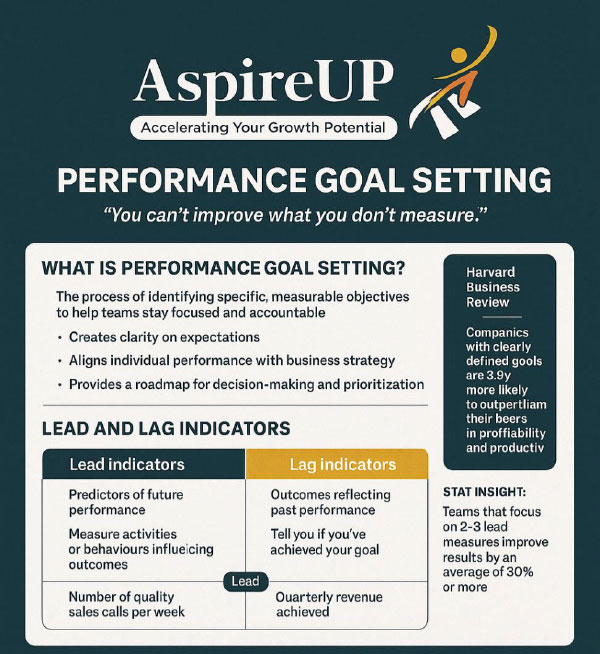Performance Goal Setting: Turning Intentions into Measurable Success
➢ “You can’t improve what you don’t measure.” – Peter Drucker
➢ In the fast-paced corporate world, performance goal setting is not just a motivational tool—it’s the engine that drives strategic execution. It’s the process of defining clear, measurable objectives that guide teams and individuals toward meaningful results, ensuring that daily efforts align with organisational priorities.
While many organisations set annual targets, the real game-changer lies in how goals are measured and tracked—and that’s where the concept of lead and lag indicators comes into play.
What is Performance Goal Setting?
Performance goal setting is the structured process of identifying specific, measurable, achievable, relevant, and time-bound (SMART) objectives that help teams stay focused and accountable. Done well, it:
Creates clarity on expectations.
Aligns individual performance with business strategy.
Provides a roadmap for decision-making and prioritisation.
A Harvard Business Review study found that companies with clearly defined goals are 3.5x more likely to outperform their peers in profitability and productivity.
The Role of Lead and Lag Indicators
1. Lag Indicators – These are outcomes that reflect past performance. They tell you if you’ve achieved your goal but do not predict future results. Examples:
Quarterly revenue achieved.
Customer satisfaction score.
Number of new accounts closed.
2. Lead Indicators – These are predictors of future performance. They measure activities or behaviours that influence the outcome. Examples:
Number of quality sales calls per week.
Response time to customer inquiries.
Percentage of team members completing skills training.
Stat Insight: According to FranklinCovey’s 4 Disciplines of Execution research, teams that focus on 2–3 lead measures improve results by an average of 30% or more.
Why They Matter Together:
Lag indicators tell you if you’re winning.
Lead indicators tell you what to do to keep winning.
Without lead indicators, teams are often reactive, celebrating or regretting results too late to make adjustments.
Corporate Best Practice Case Study: Microsoft Sales Organisation
When Microsoft restructured its global sales teams, they identified that revenue growth (lag indicator) was heavily influenced by the number of high-quality customer engagements per week (lead indicator).
Challenge: Sales teams were hitting quarterly revenue inconsistently because they were focusing on closing deals rather than consistently building their pipeline.
Solution: They implemented a system where each sales professional had to log at least 15 meaningful client engagements per week. Engagement quality was defined using a checklist of needs-based selling behaviours.
Result: Within 9 months, they recorded:
22% increase in qualified pipeline opportunities.
15% improvement in deal closure rates.
A more predictable sales cycle and reduced quarter-end pressure.
3 Tips to Improve the Consistency of Discipline in Achieving Performance Goals
➢ “Discipline is the bridge between goals and accomplishment.” – Jim Rohn
Build a Visible Scoreboard
Make lead and lag indicators visible to the team (dashboards, scorecards, weekly updates).
People play differently when they know the score.
Tip: Use simple visual tracking tools so progress is transparent and motivating.
Create Weekly Rituals of Accountability
Schedule short check-ins to review lead indicators and commitments.
Harvard research shows accountability partners increase goal achievement probability by 65%, and 95% with regular progress check-ins.
Design Systems, Not Just Goals’
Focus on habits and processes that naturally drive results.
Example: If your lag goal is “increase customer retention,” your lead measure could be “weekly follow-up calls with top 20% of clients.”
Systems reduce reliance on willpower, making consistency easier.
My Final Thoughts
Performance goal setting for me is more than just hitting a number—it’s about creating a repeatable, disciplined system that blends vision (lag) with action (lead). Organisations that master this balance build a culture of continuous improvement, where every team member knows exactly what to do today to win tomorrow!
➢ “You don’t rise to the level of your goals. You fall to the level of your systems.” – James Clear
Till the next article!
Article curated by Arvind Kumar
9 Aug 2025
